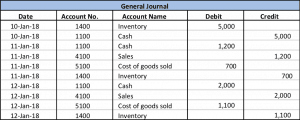Simple General Ledger Example
Definition
General ledger is the book that stores and updates all the accounts in the company when the transactions are recorded in the general journal. It is the set of accounts that contain all transactions in each account in the company. In short, it is the master of all accounts in the company.
All the accounts including in assets, liabilities, equity, revenues, and expenses that are used to make the financial statements come from the general ledger. This is why the general ledger accounts are sometimes classified into 5 categories including assets, liabilities, equity, revenues, and expenses.
The general ledger is in the format of “T”, that is why sometimes it is also called “T-accounts”, which on the left side is the Debit and the right side is the Credit.
The transactions are recorded in the general journal first, then the related accounts in the general journal will go to the general ledger.
General Ledger Example
On 10 Jan 2018, ABC Co. purchased the inventory $5,000 by cash.
On 11 Jan 2018, ABC Co. made sales on cash $1,200, in which the cost of the goods was $700.
On 12 Jan 2018, ABC Co. made $2,000 more sales on cash, in which the cost of the goods was $1,100.
The transactions would be recorded in General Journal as:

Then the transactions would be transferred to General Ledger as below:

In the past, the general ledger is usually prepared later date after the journal entry was made. It is usually done before preparing trial balance and financial statements. However, today with the accounting software such as QuickBooks or just Excel spreadsheet, the general ledger can be automatically generated at any given point of time without the need to be manually prepared by transferred transactions, account by account, from a general journal like in the past. All that required are the journal entries to enter into the company’s accounting software.
General ledger is very important in the company’s accounting system as it serves as the basis of the preparation of financial statements. Simply put, the whole financial statements are created from the general ledger accounts.